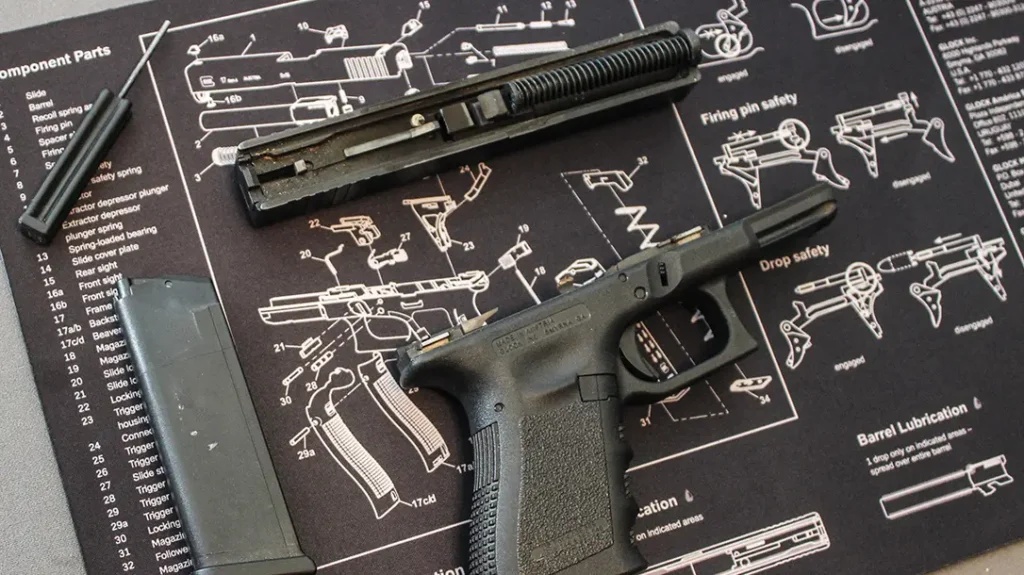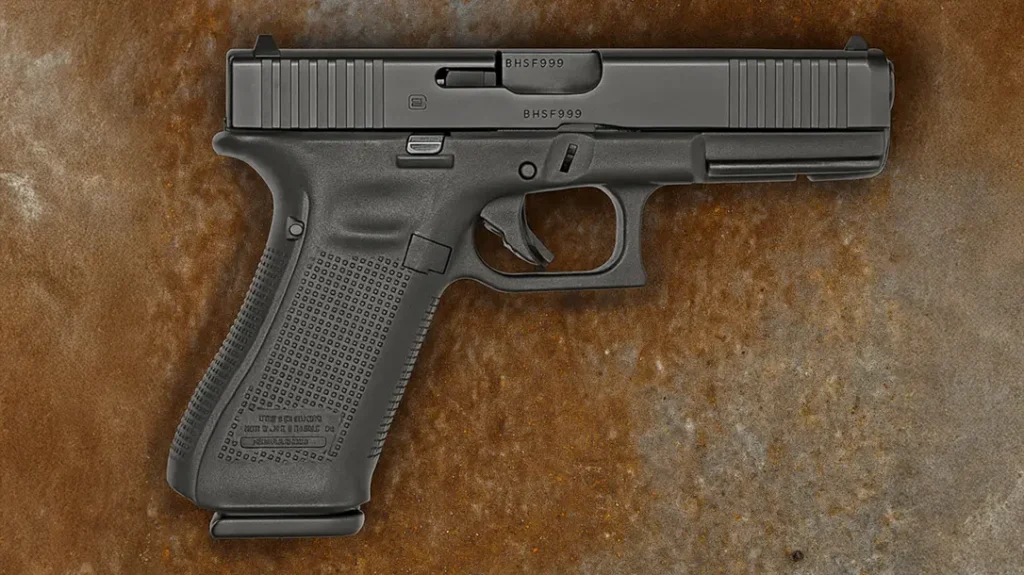When the Glock 17 debuted in the early 1980s, it didn’t arrive with fanfare so much as with quiet, stubborn competence. Designed by Gaston Glock, it is a tribute to simplicity and function. Glock was an engineer with a background in plastics rather than a pedigree in firearms manufacturing, which allowed him to “think outside the box.” The pistol introduced a new philosophy to service handguns: be reliable as the sunrise, then optimize the essentials. Decades later, the Glock 17 remains a benchmark in reliability, ergonomics, and modularity. It is a tool that fundamentally changed how militaries, police agencies, and civilian shooters think about handguns.
The Glock 17 – The Genesis of Modern Handguns
The Glock 17’s origins are pragmatic. Austria’s military sought a modern sidearm to replace older designs, and Glock answered with a polymer-framed, striker-fired 9mm. It offered a design that prioritized ease of manufacture and operational dependability. Its designation “17” stemmed from Glock’s internal patent numbering, though the original magazine’s 17-round capacity made for a tidy coincidence that the market readily embraced. What set the design apart was not a single revolutionary component but the accumulation of small, thoughtful choices. It has a corrosion-resistant polymer frame that reduces weight without sacrificing durability. The 17 has a simple, robust steel slide, barrel, and a trigger and firing mechanism conceived for consistency under stress.
Advertisement — Continue Reading Below
The Glock’s “Safe Action” system highlights that design ethos. Rather than multiple manual safeties and complex decocking levers, Glock employed a passive three-part safety system that disengages as the trigger is pulled and resets when released. To the end user, this translates to an intuitive, repeatable action. Simply present, press, and fire. That simplicity is the fruit of careful engineering. The mechanism is deliberately straightforward to minimize failure in adverse conditions, and it has proven remarkably resilient to neglect, abuse, and environmental extremes.

Performance Centered
Performance is where the Glock 17 earned its reputation. The grip angle and slim profile provide a natural point of aim for many. The polymer frame absorbs and manages recoil in a way that keeps follow-up shots controllable, and the standard 17-round magazine capacity represented a tactical advantage in an era when most service pistols held fewer rounds. More than aesthetics or novelty, it was the Glock’s track record under stress that helped make it a legend. Its ability to run reliably after exposure to dirt, mud, water, and extreme temperatures made agencies take notice. Law enforcement departments worldwide adopted the Glock 17 because operational reliability is non-negotiable when lives are at stake.
Advertisement — Continue Reading Below
Over time, Glock evolved the platform rather than reinventing it. Generational updates introduced refinements such as grip texturing, an ambidextrous slide stop in later variants, an improved “Marksman” barrel, and modifications to the trigger geometry, while keeping the core architecture intact. Those incremental changes responded to user feedback across diverse applications, from concealed carry and home defense to competitive shooting and special operations. A massive aftermarket reinforces the 17’s adaptability. There is everything from optics-ready slides, threaded barrels, enhanced sights, and trigger upgrades. This transforms the Glock 17 from a standard-issue sidearm into a highly specialized tool for specific tasks.

Practical Accuracy
Accuracy with the Glock 17 is often framed in practical terms. It is not a precision target pistol by design, but for a service-oriented 9mm, it is exceptionally capable of tight, serviceable groups at typical engagement distances. The combination of a consistent trigger pull and Glock’s later barrel refinements produces reliable accuracy. Where some competitors chased cosmetic or mechanical complexity, Glock doubled down on repeatability. In my opinion, that is the single attribute that separates a defensive firearm from a decorative one.
Advertisement — Continue Reading Below
The Glock 17’s legacy is visible in the industry-wide embrace of striker-fired, polymer-framed designs. Its introduction forced other manufacturers to rethink production techniques, materials, and ergonomics. Today’s pistol market, with optics-ready platforms, modular backstraps, and high-capacity magazines, is a reflection of Glock’s influence at every turn.

The Glock 17
For both beginning and experienced shooters, the Glock 17 serves as a case study in handgun engineering. It is not merely an object of fanatical brand loyalty; it is an exercise in solving core problems with durable, no-frills solutions. Whether issued to police officers standing watch in urban precincts, slipping into the holster of a concealed-carry permit holder, or customized into a competition-grade pistol, the Glock 17’s most enduring trait is predictability.
Advertisement — Continue Reading Below
Gaston Glock’s pistol did not focus on ornamentation or historical pedigree. He rewired expectations about what a service pistol should be. Decades of incremental improvement and widespread adoption have made it as popular today as it was when it first launched. These evolutions have only underscored why a design focused on function above flourish can endure. For shooters who value a platform that is proven, adaptable, and unerringly utilitarian, the Glock 17 remains a relevant, if unglamorous, benchmark in modern handgun design.
For more information, visit Glock.
Advertisement — Continue Reading Below
WHY OUR ARTICLES/REVIEWS DO NOT HAVE AFFILIATE LINKS
Affiliate links create a financial incentive for writers to promote certain products, which can lead to biased recommendations. This blurs the line between genuine advice and marketing, reducing trust in the content.


